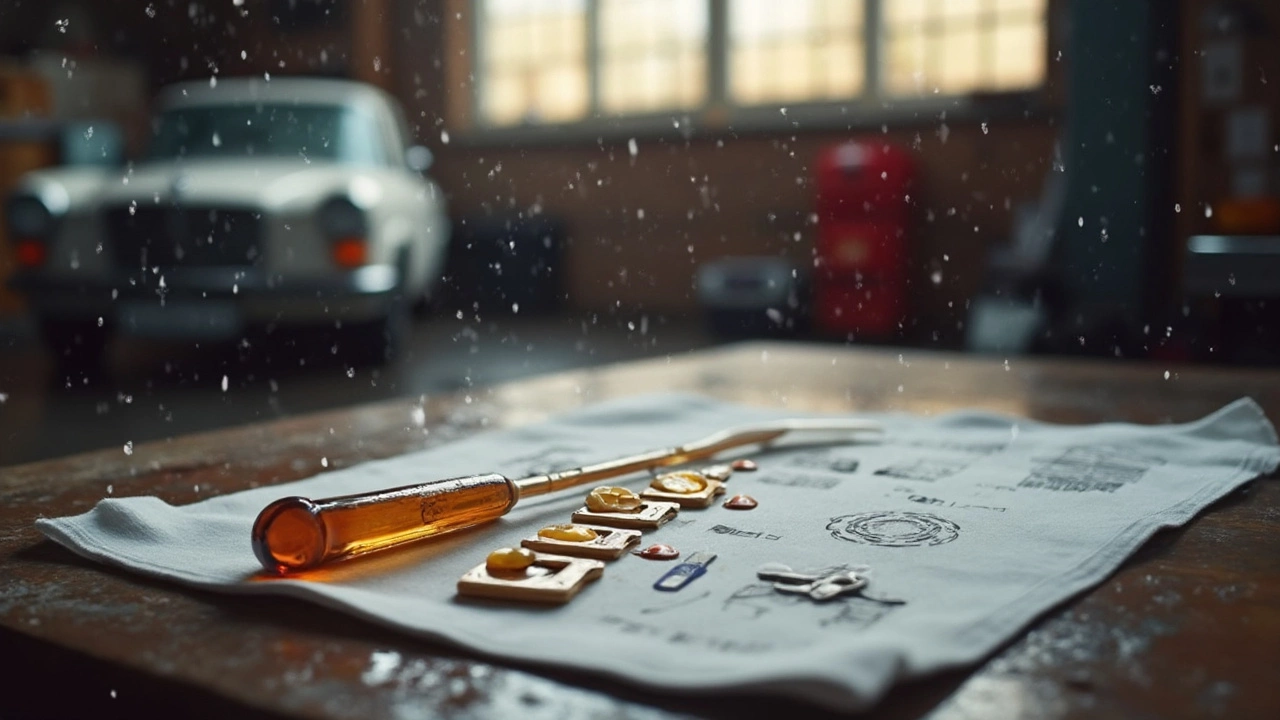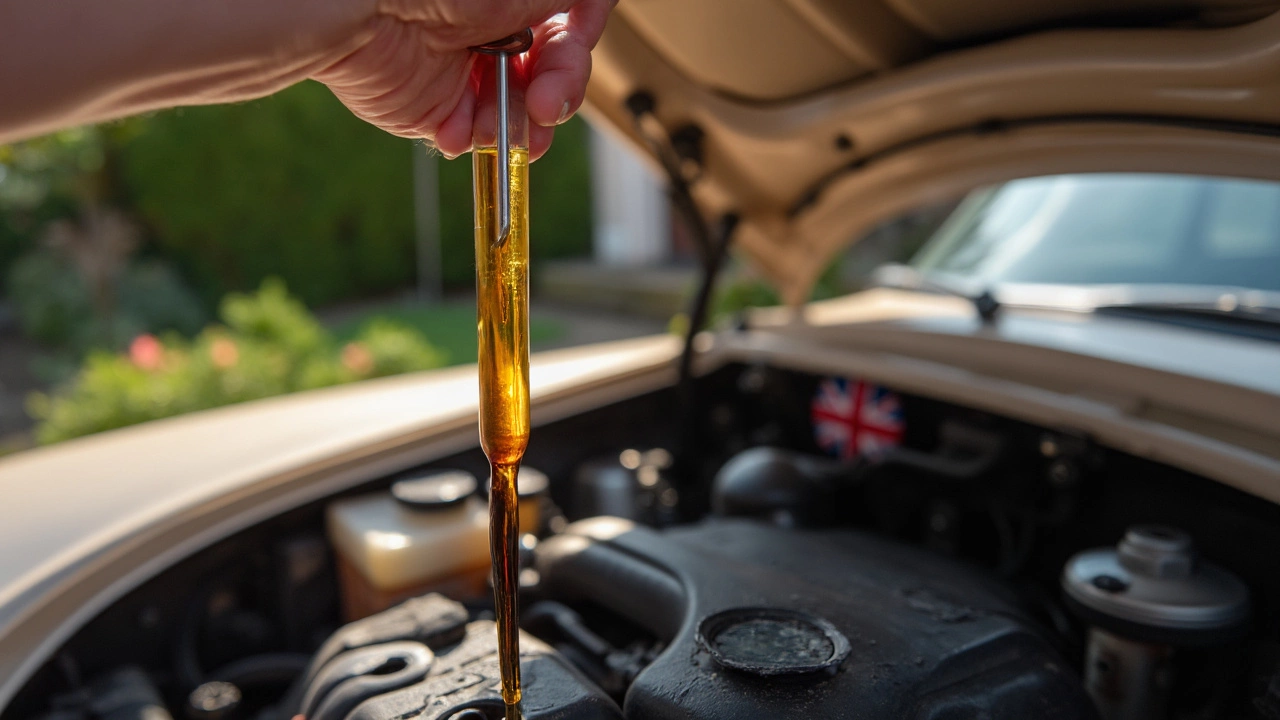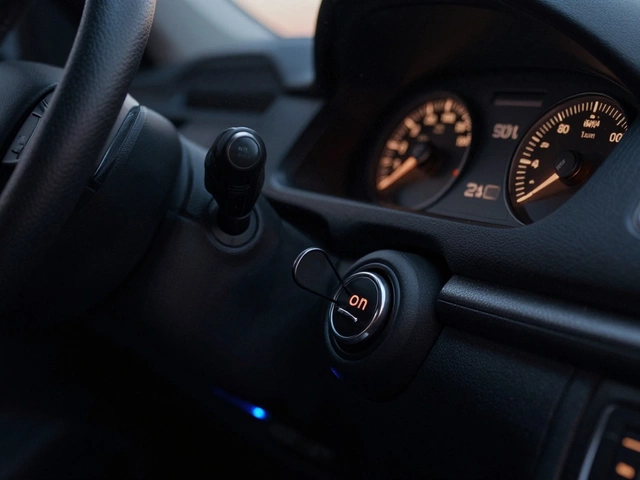Pop that hood, pull the dipstick, and make sure you actually know what you're looking for—because oil color isn’t just a random thing. Fresh engine oil usually starts out honey-gold or amber, depending on the brand and type. But that color doesn’t last long once it’s in your engine. What matters is not just sticking with one shade, but understanding what different colors can mean for your engine's health.
If you’ve ever panicked after seeing black or dark brown oil on your dipstick, relax. Oil picks up dirt, soot, and engine particles almost right away, so it darkening up is totally normal. The real red flags come when you spot colors like milky chocolate (think a melted milkshake), gray sludge, or anything with sparkly bits—those can mean water in your oil, coolant leaks, or metal shavings, none of which are good news.
- What Fresh Engine Oil Looks Like
- How Oil Changes with Use
- Colors That Spell Trouble
- How to Check Oil Correctly
- Oil Additives and Color Myths
- When to Change Oil—Don’t Just Trust the Color
What Fresh Engine Oil Looks Like
If you’ve ever poured new oil into your car, you’ll notice it has a clean, see-through look right out of the bottle. For most vehicles, fresh oil is a light amber or golden brown color. It should look pretty clear, almost like a bottle of light honey or syrup. If you hold the dipstick up to the light after adding new oil, you’ll be able to see through it easily. That’s your baseline for how clean oil should look.
Different oil brands can have tiny color differences, but they all stay in that clear, light-amber range—unless you’re using a specialty oil or one with a dye added (like some high-mileage or performance oils). Here’s a quick breakdown to help you visualize:
| Type | Typical Fresh Color | See-Through? |
|---|---|---|
| Conventional Oil | Light golden/amber | Yes |
| Synthetic Oil | Slightly lighter or even pale yellow | Yes |
| Diesel Engine Oil | Amber to darker brown (even when new) | Semi-clear |
One thing to remember—if your new oil looks dark, chunky, milky, or has any kind of particles floating in it, don’t use it. That’s a sign something’s wrong with the batch or it’s been sitting for too long. Oils have a shelf life, usually about five years. Always check the bottle for the viscosity number (like 5W-30) and make sure it matches your car’s manual before pouring.
For the most part, the engine oil color gives you a quick peace of mind that you’re starting with a healthy base in your engine. Trust your eyes: clear, light, and smooth is what you want to see on that first dip.
How Oil Changes with Use
Oil doesn’t stay pretty for long. Right after you pour that fresh, golden stuff into your engine, it starts mixing with dirt, heat, and combustion byproducts almost instantly. That's just how engines work. Over a few hundred miles, the oil usually turns from clear amber to a darker brown. This is normal and even means your oil is doing its job—trapping all the nasty stuff that could harm your engine.
Heat is a huge factor here. The constant up-and-down of engine temperature makes oil thinner, and after weeks of driving, it gets darker and less transparent. Directly after an oil change, the oil on your dipstick should be transparent, but over time, it starts to look thicker, and you might notice it’s a deep brown or almost black. This doesn’t mean you need to panic or rush to change it—oil naturally darkens as it cycles through dirt and chemicals.
Here’s a quick breakdown of what you can expect the oil to look like over time:
| Miles Driven | Typical Oil Color | Texture |
|---|---|---|
| 0 (fresh) | Amber/light brown | Clear, smooth |
| 500 - 1500 | Medium brown | Still clear, a bit darker |
| 2000 - 3000 | Dark brown | Less clear, slightly thicker |
| Over 4000 | Very dark/black | Thick, may lose transparency |
Why does this happen? The main culprits are carbon particles from fuel, microscopic engine wear, and sometimes just normal boiling and breakdown of the oil's additives. If you drive in dusty, stop-and-go, or really hot conditions, you’ll see the color change even faster. This is exactly why most pros recommend checking your engine oil color every couple of weeks and before big trips.
One tip: Smell your oil. Seriously. If it smells burnt, that’s a bigger issue than just dark color—it may be overheating or breaking down too fast. Another thing, if you wipe your dipstick and notice sludgy or gritty stuff instead of a smooth film, that’s a sign the oil is failing and your engine needs help.
Colors That Spell Trouble
If you pull the dipstick and see anything other than that usual brown or black, it’s time to pay attention. Strange colors in your engine oil can point to real problems brewing under the hood. Here’s what you need to keep in mind when looking at the engine oil color on your dipstick.
- Milky or creamy oil: This isn’t normal. When oil turns milky, it usually means there’s water or coolant leaking in. Common causes include a blown head gasket or a crack somewhere in the engine. If you notice this, don’t ignore it—driving like this could wreck your engine fast.
- Gray or very foamy oil: Excess foam or a gray color can mean contamination, possibly from coolant or water, but sometimes just from too much air or a bad oil type. Still, it’s a sign that the oil isn’t protecting as it should.
- Red or pinkish oil: Standard motor oil doesn't turn red. If you spot this, look around for a transmission fluid leak, especially if you recently had work done in your engine bay. Transmission fluid is usually red or pink.
- Glittery or metallic-looking oil: If you see sparkling bits, that's usually metal shavings. Engines naturally shed some metal over time, but if you see enough to notice with your eye, you've likely got a bigger mechanical issue like worn out bearings or other moving parts grinding down.
To make sense of what you’re seeing, here’s a quick table for reference:
| Oil Color / Appearance | Likely Cause | What to Do |
|---|---|---|
| Milky or creamy | Coolant or water contamination | Get your engine checked ASAP |
| Gray/foamy | Possible coolant, bad oil, or overfilling | Stop driving, check for leaks, get oil changed |
| Red or pink | Mixing with other fluids (like transmission fluid) | Look for leaks, get it fixed |
| Black with metallic flakes | Engine wear (metal in oil) | Service the engine right away |
If your oil is just dark but smooth, it’s probably doing its job. But when you see odd colors or textures, get your car into a trusted shop right away. Small problems can turn ugly fast, and ignoring odd oil color is a surefire way to end up paying way more.

How to Check Oil Correctly
If you want a healthy engine, you have to check your oil the right way—just rolling up, yanking out the dipstick and glancing at it isn’t enough. It’s honestly amazing how many people miss the basics here. If you don’t do it right, you can get misleading readings and miss actual problems brewing inside your motor.
Here’s the step-by-step that even the pros follow:
- Make sure your car is parked on level ground. Uneven surfaces mess with the oil reading and you don’t want that.
- Wait for the engine to cool down if it’s been running; five to ten minutes after turning it off is perfect. Hot oil splashes all over the dipstick tube and gives you a false read.
- Pop the hood and find the dipstick—usually it’s got a bright handle (yellow, orange, or red). Pull it out, but don’t look just yet.
- Wipe the dipstick clean with a rag or paper towel. This step is key, otherwise old oil stuck to the stick will throw you off.
- Slide the dipstick all the way back in, wait two seconds, then pull it out again. Now check the oil color and level. Look at the marks—there’s "min" and "max", or holes or lines showing safe range.
- Hold the dipstick under natural light for the best view. Check for the engine oil color (amber and translucent is best; black and thick isn’t always bad, but milkiness or foam is a problem).
Here’s a tip from the Car Care Council:
“Checking your oil regularly helps prevent engine wear and gives a good snapshot of your engine’s condition—even before any warning lights turn on.”
Always wait for the engine to cool before you check, and keep an eye out for weird smells or globs in the oil. If the level’s below minimum or the color is strange, don’t just top off and forget. Figure out what’s really going on or ask your mechanic. Catching issues early with a quick dipstick check can save you a ton in repair bills down the road.
Oil Additives and Color Myths
Lots of folks swear you can tell everything about your engine just by looking at the oil’s color. The truth? It’s not that simple thanks to oil additives. Modern engine oils have a mix of cleaning agents, anti-wear stuff, and detergents. Some of these can darken the oil pretty fast, even when it’s still working just as it should.
People often think fresh oil should always look light and clear, but that’s not always the case. Some synthetic oils come out of the bottle darker than others. And if you’re using high-mileage or heavy-duty oil, extra additives for old seals or cleaning might start out with a tint.
Additive packs (these blends of chemicals) help engine oil handle heat, prevent sludge, and stop wear. But they can change the oil's look. For example, dispersants and detergents grab carbon and grime, making the oil turn dark fast—even if nothing’s wrong. Seeing darker oil doesn't automatically mean it’s time for a change.
Check this out—a popular study by the Petroleum Quality Institute found that some oils, especially synthetics with lots of zinc or phosphorus, come out almost coffee-brown straight from the bottle. Meanwhile, basic mineral oils often look lighter. Here’s a quick snapshot:
| Oil Type | Typical Color (New) | Main Additives |
|---|---|---|
| Basic Mineral Oil | Light Amber | Simple detergents, basic anti-wear agents |
| Full Synthetic Oil | Amber to Medium Brown | Zinc, phosphorus, advanced cleaners |
| High-Mileage Oil | Darker Amber or Brown | Seal conditioners, extra detergents, friction modifiers |
So, don’t judge your engine oil color too quickly. Instead of color, focus on changes in texture—like sludgy buildup, a milky appearance, or metal flecks. Those are always warning signs, no matter what additives you’re using. Skip the myths and use your dipstick as one part of your check, not the whole story.
When to Change Oil—Don’t Just Trust the Color
Lots of folks think if their oil looks dark, it’s time for an oil change. Here’s the thing: color isn’t the whole story. Oil gets dirty fast, even after just a few miles, and a dark dipstick doesn’t always mean your oil is shot. Modern oils are designed not just to lubricate but also to grab up grime, so getting darker can actually mean it’s doing its job.
If you only go by color, you could be dumping perfectly good oil—or, worse, keeping bad oil in because it ‘looks okay.’ It’s all about what your car’s manual says, not just what your eyes see. Most automakers suggest an oil change every 5,000 to 7,500 miles for regular driving, but newer synthetic oils can sometimes go 10,000 miles or more. And some high-tech cars even come with sensors that track oil life based on how you drive.
"Relying strictly on oil color can be misleading. Always follow your manufacturer's maintenance intervals and use the dipstick for oil level, not just color," recommends Edmunds.com, a trusted auto advice site.
Here’s what actually matters more than color:
- Mileage since your last oil change
- How hard or how gently you drive (lots of short trips and stop-and-go? That’s tough on oil)
- Engine sounds or knocking you didn’t hear before
- Warning lights on your dashboard
Check this out for a few basic oil change intervals:
| Oil Type | Typical Interval (Miles) |
|---|---|
| Conventional Oil | 3,000 – 5,000 |
| Synthetic Blend | 5,000 – 7,500 |
| Full Synthetic | 7,500 – 10,000+ |
The takeaway: use color as one clue, but don’t make it your main rule. Your car’s engine oil color will get darker just from doing its job. Stick to scheduled changes, watch your miles, and listen to your car. If in doubt, check the dipstick for texture or that ‘burned’ smell—those are bigger trouble signs than a dark tint.








